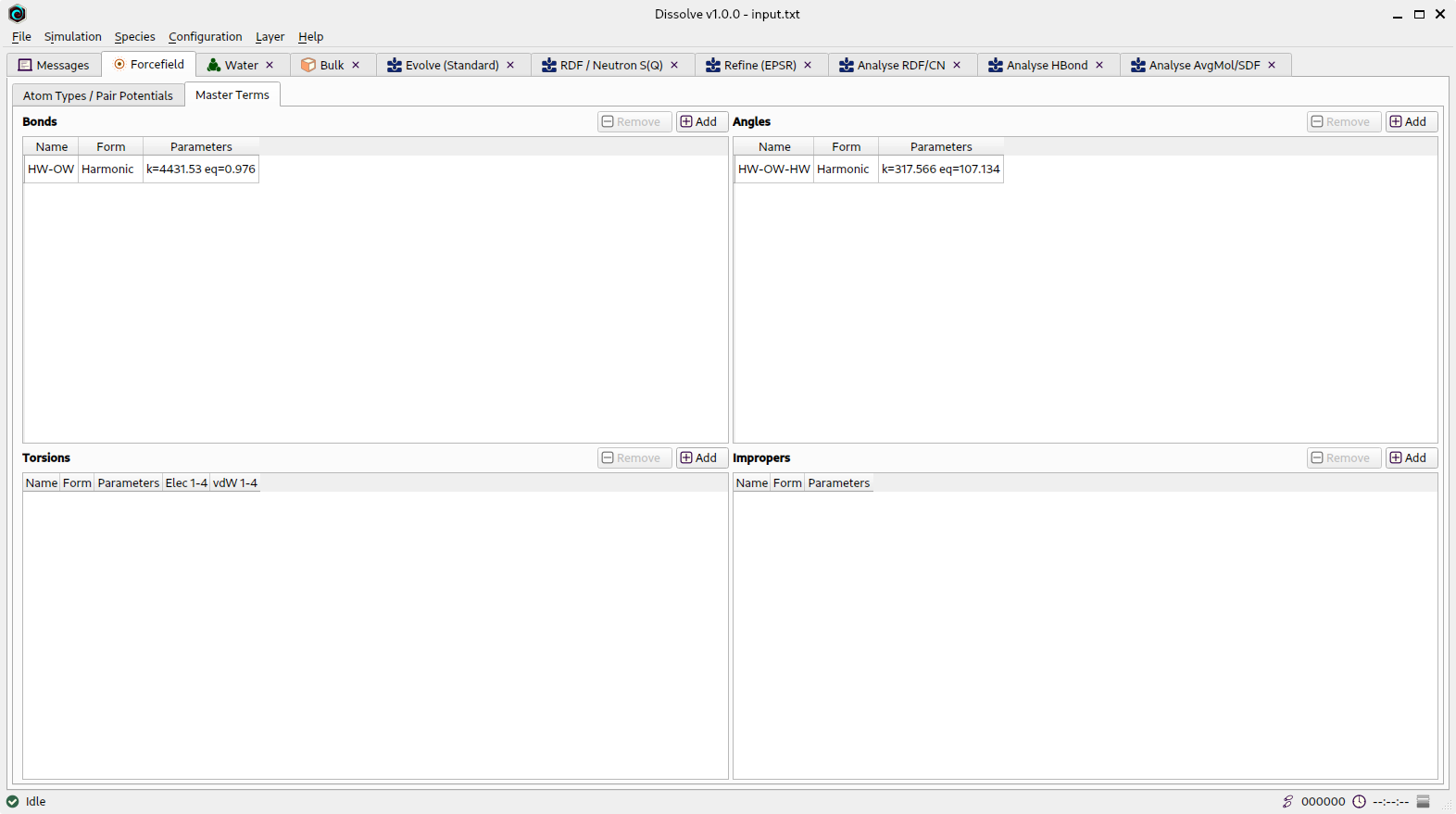Main Forcefield
The purpose of the Forcefield tab is to provide access to general forcefield terms used within the simulation, covering atom types and master terms.
Atom Types & Pair Potentials

Forcefield tab showing current atom types and potentials
Basic editing of atom types (addition, duplication etc.) is provided by this tab, as well as control over the generated pair potentials. Of particular importance are the options to control the cutoff distance of the potential and the source of atom charges in the generated potentials.
Atom Types List
The left-most list shows the current atom types defined for the simulation, including their potential parameters - charge and short-range (SR) definition. Both may be edited freely from here.
Pair Potentials
Pair potentials are generated from the potential parameters defined for the atom types, in conjunction with the Charge Source option. If the current simulation hasn’t already been prepared or run then clicking the Regenerate All button will recalculate all pair potentials.
Selecting a pair potential from the list plots the tabulated energy and force functions.
Control
The pair potential Range determines the extent over which pairwise interactions between atoms are effective in the simulation. Typically this is between 10 to 15 Angstroms, but may need to be made larger in extreme cases. It is important to note that the longer the pair potential range, the longer it takes to calculate total system energies, and the more time it will take your simulation to run.
The Delta value controls the spacing between points, in Angstroms, in the tabulated pair potentials. The default value is sufficient for most cases and should not normally need to be changed.
Short-Range Truncation
The short-range part of the potential typically goes close to zero at longer distances (past 10 Angstroms) but doesn’t go exactly to zero, creating a discontinuity in both energy and force which will cause significant artifacts in any simulation. Thus, a suitable truncation scheme must be employed to ensure that the energy and force go smoothly to zero at the limit of the pair potential.
Coulomb Truncation
In an analogous manner to the short-range part of the potential, the Coulombic term must also be made to go to zero at the limit of the pair potential.
Charge Source
When Choose Automatically is enabled for the charge source (the default) Dissolve will make a choice over where to take atom charges for the pair potentials:
- Atom Types - Tabulated pair potentials will include a Coulombic term based on the charges defined for individual atom types in the left-most list.
- Species Atoms - Tabulated pair potentials will only include the short-range part of the potential - Coulomb interactions will be calculated on-the-fly using charges specified on individual species atoms.
Of the two options, Species Atoms is much more flexible in terms of specifying fine-grained, realistic charge distributions, but is slower to calculate.
When attempting to choose which scheme to use Dissolve may fail to make a definite choice and refuse to proceed. This can happen if there are a suspicious number of atom types or species atoms with exactly zero charge, for instance. In those cases you must intervene and untick Choose Automatically and make the choice yourself. Note that Dissolve may still complain about your choice and refuse to run, in which case you must evaluate the situation and, if things are as you want them, select the Force Choice option.
Master Terms

Forcefield tab showing current master terms
Any defined master terms are shown here with their parameters, split into the different intramolecular interaction types. Parameters may be freely edited here (note that they cannot be edited from a species which references the master term).